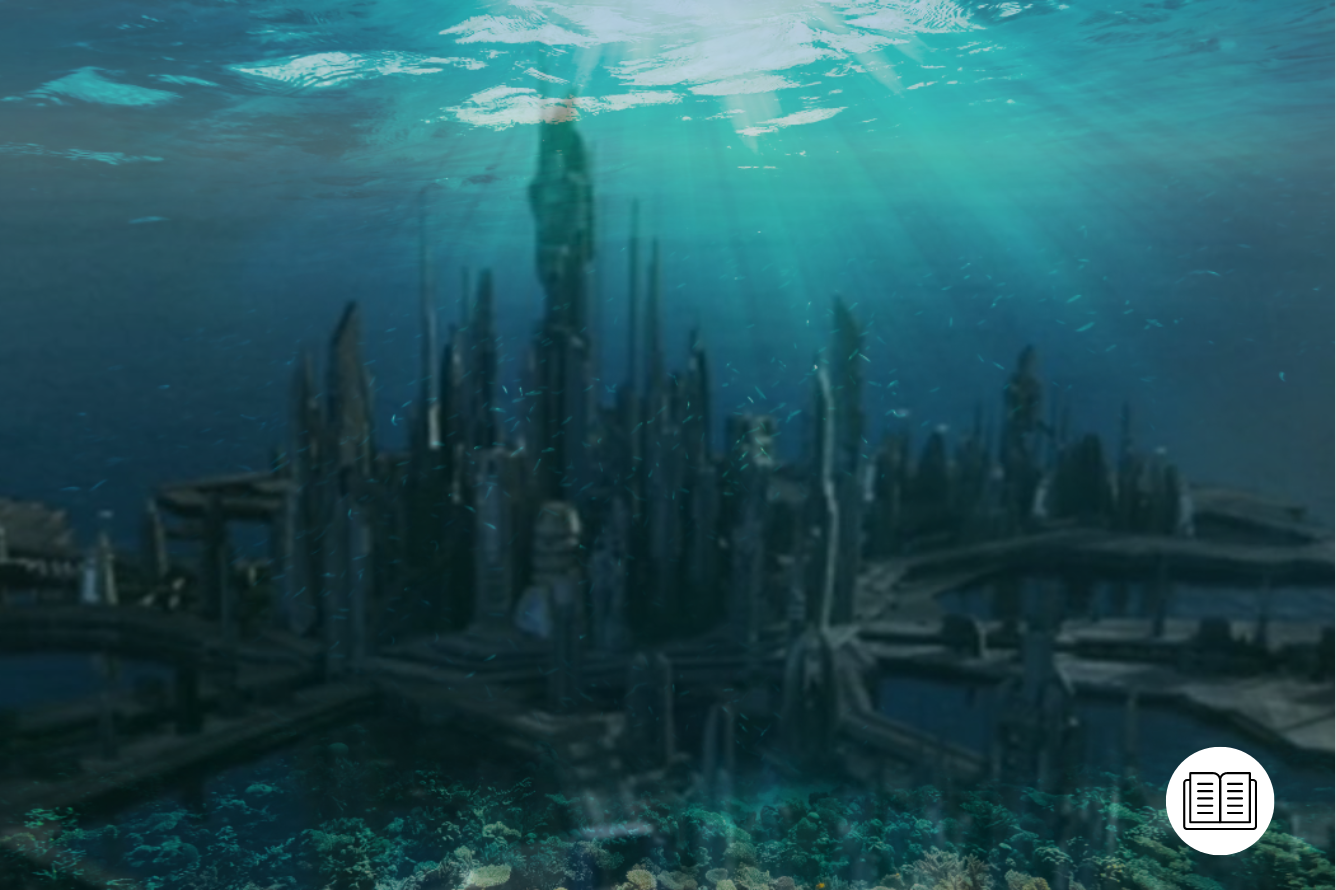Stargate SG-1 loved using different Earth mythologies and folklore to inform the series’ own, internal mythology of interplanetary travel, the Asgard, the Goa’uld, the Ori, etc. It’s then little wonder that Atlantis – which has become part of pop culture – was also utilized in the overall storyline
Stargate SG-1 loved using different Earth mythologies and folklore to inform the series’ own, internal mythology of interplanetary travel, the Asgard, the Goa’uld, the Ori, etc. It’s then little wonder that Atlantis – which has become part of pop culture – was also utilized in the overall storyline.
In this article, I’m going to have a look at the original Atlantis myth by Plato, before moving on to other interpretations of it, and finally looking at the ways in which Stargate SG-1 makes use of the Atlantis myth.

The Beginning of Atlantis: Plato and His Works
Unusually for mythology, we can pinpoint the start of the Atlantis story – or at least, pinpoint the moment when the Atlantis story “went mainstream.” The Greek philosopher Plato (c. 429–347 BCE) is the first to write about the island of Atlantis and give a detailed description of the island in his works.
Who was Plato?
Plato has been described as “one of the most dazzling writers in the Western literary tradition and one of the most penetrating, wide-ranging, and influential authors in the history of philosophy.” About his work, it has been stated that “educated readers of nearly every period have in some way been influenced by him.”
Amongst Plato’s most well-known works are, probably, The Republic (circa 375 BCE), Timæus (circa 370 BCE), and Critias (circa 360 BCE) – the Socratic dialogues in which descriptions of Atlantis and its downfall and destruction can be found.
Plato’s Atlantis: A Bronze Age Allegory
(Quotes from Plato’s works and their numbering are taken from the Perseus Digital Library.)
In section 24e of Timæus, Plato – through the character of an Egyptian priest – writes the following about Atlantis: “In front of the mouth which you Greeks call, as you say, ‘the pillars of Heracles’, there lay an island which was larger than Libya and Asia together; and it was possible for the travelers of that time to cross from it to the other islands, and from the islands to the whole of the continent over against them which encompasses that veritable ocean.”

In section 25a and 25b of Timæus: “In [Atlantis] […] there existed a confederation of kings, of great and marvelous power, which held sway over all the island, and over many other islands also and parts of the continent; and, moreover, of the lands here within the Straits they ruled over Libya as far as Egypt, and over Europes as far as Tuscany.”
The island of Atlantis and its city of the same name is described in some detail by Plato in Critias. Atlantis was arranged in concentric circles of alternating water and land – and that was just the beginning of its wonders. Levy (2007:20) notes that the city of Atlantis was “a model ancient metropolis […] appointed with every marvel that Bronze Age civilization could offer.
“The soil was rich […] the engineers technically accomplished, and architecture extravagant with baths, harbor installations, and barracks,” Gill (2018) writes in the article Atlantis as It Was Told in Plato’s Socratic Dialogues. But it’s not just the irrigation system, architecture, and luxuries that made Atlantis such an envious address; it was also its rulers. Atlantis’ rituals also matched Athens’ “for bull-baiting, sacrifice, and prayer.” (Gill, 2018)

Atlantis, however, was destroyed by the gods and it sank beneath the ocean along with its inhabitants. Plato describes this as follows in section 25c and d of Timæus: “But at a later time there occurred portentous earthquakes and floods, and one grievous day and night befell them when the whole body of your warriors was swallowed up by the earth, and the island of Atlantis in like manner was swallowed up by the sea and vanished; wherefore also the ocean at that spot has now become impassable and unsearchable, being blocked up by the shoal mud which the island created as it settled down.”
Atlantis in its Platonic Context
With a keen interest in the perfect state and the perfect form of government, it’s quite easy to see why Plato would use Atlantis as a cautionary tale for hubris and imperial ambition. Levy (2007:18), in The Atlas of Atlantis and Other Lost Civilizations, notes that Plato was – after the trial and execution of Socrates – highly suspicious of “the danger of mob rule and what could happen if the uneducated and unvirtuous were allowed too much say in affairs.”
Rather than having Atlantis be the perfect state, however, Athens comes to the fore as a type of ideal state (see Levy, 2007:19). This is because Athens – in Plato’s description of Atlantis – is the opposite of the “overbearing imperial” power of Atlantis when its “rule of law and […] respect for the rights of their citizens” goes astray (see Levy, 2007:18–19). Athens stands up against Atlantis and because of its hubris, Atlantis is punished and sinks beneath the ocean with all its inhabitants.
Plato’s description of Atlantis originated with his ancestor, Solon (circa 630-circa 560 BCE), who came across the details of the story during his travels in Egypt. Solon brought the tale to Ancient Greece, and Plato recorded it at a later date, using it as an allegory for the superiority of Athenian democracy over earlier civilizations. This allegorical use of Atlantis is echoed by later political writers – particularly in the European Rennaissance – such as Francis Bacon in New Atlantis (1626) and Sir Thomas More in Utopia (1516).
Some Speculated Sites of the “Real Atlantis”
Many have understood the story of Atlantis to have been inspired by historic events and many sites around the world have been postulated to be Atlantis; from Carthage to Troy and beyond. Whilst there’s no “real Atlantis” in the literal sense, just as the “ancient Athens” described by Plato was instead an idealized form of the contemporary Athenian Republic, the world of antiquity offers many alternatives for the tale that captivated Solon in Egypt.
The Island of Crete and the Minoans
Probably one of the best-known places thought to be the inspiration for Atlantis is the Island of Crete and the Minoan civilization that thrived there some four millennia ago. Memories of the Minoans are believed to have inspired the Atlantis that was described to Solon in Egypt. With its colorful frescoes, art, and sophisticated architecture like the Knossos Palace, there can be little question that this was an important part of the Bronze Age Aegean world.
The Minoan civilization developed in Crete from approximately 2600 BCE (Levy, 2007:40), reaching its apogee at around 1900 BCE “with the establishment of centers, called palaces, that concentrated political and economic power, as well as artistic activity, and may have served as centers for the redistribution of agricultural commodities,” according to Colette Hemingway at the Metropolitan Museum of Art.
Levy (2007:41) notes that “[t]hanks to the eruption on Thera, the Minoans may have suffered a cataclysm of earthquakes and floods, which led to their downfall.” Thera, now known as Santorini, was home to the prosperous Minoan port of Akrotiri, completely destroyed by a volcano in the 16th century BCE. Like Pompeii, Akrotiri is incredibly well preserved and archaeologists have uncovered paved roads, three-story buildings, and advanced drainage systems.
Crucially for putting Akrotiri into Solon’s account, the eruption of Thera was noted by Egyptian chroniclers – most famously on the contemporary Tempest Stele erected during the reign of Ahmose I, which describes the dramatic environmental effects of the disaster to their north:
[Then] the gods [caused] that the sky come in a tempest of r[ain], with [dark]ness in the condition of the West, and the sky being in storm without [cessation, louder than] the cries [lit., “voices”] of the masses, more powerful [than . . .], [while the rain howled] on the mountains louder than the sound of the underground source of the Nile that is in Elephantine.

The City-State of Helike in Greece
At one time the leading Greek city-state in Classical Greece and revered as a center of Poseidon worship (Levy, 2007:28), Helike had been lost beneath the waters of the Mediterranean Sea after a cataclysmic tsunami in 373 BCE following an earthquake that struck the southwest shore of the Gulf of Corinth (see the Helike Project). The city of Helike was submerged and only finally rediscovered in 2001.
After more than a decade of archaeological excavations by the Helike Project, the 373 BCE destruction layer was uncovered in 2012. The destruction layer revealed “cobblestones from destroyed walls, large clay roof tiles, and pottery dated to the Classical period” the Helike Project noted. This attests to the destruction described in ancient sources when “Helike was wiped off the face of the Earth by a tremendous cataclysm” (Levy, 2007:28) in one night.
There are a number of parallels between the city-state of Helike and Atlantis, both being powerful city-state with colonies, both worshipping Poseidon as their principal deity, both being destroyed in a matter of hours by an earthquake and tsunami or flood, and both sinking beneath the waves (see Levy, 2007:28). It was even rumored that “Poseidon had punished [Helike] for its arrogance in refusing to support temples to him […] in its colonies or […] for having defiled the sanctuary dedicated to him.” (Levy, 2007:29).
As Plato was about 54 years old when disaster struck Helike, it could very well be that the philosopher took some inspiration for his Atlantis myth from this catastrophic event. Levy (2007:29) notes that “it seems plausible that if Plato wanted to invent a fictitious civilization to illustrate his political philosophy […] his thoughts would inevitably turn towards Helike.”
19th and 20th Century Theories About Atlantis
One of the people that had the biggest impact on the modern ideas surrounding Atlantis is Ignatius Loyola Donnelly (1831–1901). Author of Atlantis: The Antediluvian World (1882), Donnelly was an American Congressman, populist writer, and fringe scientist. He is now mostly known for his Atlantean theories and Catastrophism.
Igantius Donnelly argued that Plato was relaying history in his Dialogues and not a “moral or philosophical fable” and that “Atlantis had indeed existed in the middle of the Atlantic […] and had indeed perished in a sudden deluge.”(Levy, 2007:62) He further claimed that all of the known ancient civilizations were descended from the inhabitants of Atlantis, with Egypt being the oldest of the Atlantean daughter civilizations (see Levy, 2007:62).

Donnelly further claims that the original source of metallurgy, agriculture, pyramid-building, writing, and various other technologies all originated in Atlantis. Even ancient languages and their modern descendants and similarities in religions across the world could, according to Donnelly, be traced back to Atlantis. For example, the “mythical and divine figures of religions hailing from the Nile Valley to Scandinavia and India could all be traced back to real kings, queens, and heroes of Atlantis.” (Levy, 2007:62) Not to mention that the various flood myths in different cultures were claimed to be “race memories” of Atlantis’ destruction. He fretted that like Atlantis, the United States was a society at its technological and economic might, and like Atlantis, was hovering on the brink of collapse.
The Atlantis book by Donnelly gained many Atlantean enthusiasts, including Madame Blavatsky, Edgar Cayce, Rudolf Steiner, and Augustus le Plongeon to name but a select few. Madame Blavatsky and the Theosophists have also become a cornerstone of Atlantology.
Madame Blavatsky (1831–1891) – whose full name was Helena Petrovna Blavatsky – synthesized traditions, myths, and legends from various cultures around the world and created Theosophy – a discipline that would go on to have a worldwide impact. In 1837 Blavatsky moved to New York, where she founded the Theosophical Society (theosophy means “wisdom of the gods” in Greek), which propounded “an eccentric blend of esoteric wisdom, garbled ‘Oriental’ philosophy, spiritualism, religion, occult lore, and pseudo-scientific thinking.” (Levy, 2007:82)
Blavatsky wrote various books, one of which – The Secret Doctrine (1888) – had as a theme lost continents, for example, Lemuria (which was first proposed in 1864 as a kind of landbridge by Philip Sclater). This “lost supercontinent” was said to stretch across the Pacific and Indian Oceans and existed before Atlantis. It is also Blavatsky who starts the idea that “humankind had evolved in phases, or Root Races, each of which had corresponded to a land-mass (sic).” (Levy, 2007:82)

Rudolf Steiner (1861–1925) was an “Austrian-born spiritualist, lecturer, and founder of Anthroposophy, a movement based on the notion that there is a spiritual world comprehensible to pure thought but accessible only to the highest faculties of mental knowledge.” (see Britannica). A polymath, Steiner also lectured on Lemuria and Atlantis and was a part of Madame Blavatsky’s Theosophical Society before starting his own movement called Anthroposophy in 1912, which – despite Steiner’s own opposition to nationalism – influenced the ideologies of the emerging German and Austrian far right. (see Levy, 2007:88 and Britannica)
Steiner did “occult investigations” into the history of Atlantis, and was the person who “helped to introduce the now broad assumption … that the Atlanteans had psychic powers,” specifically telepathy and psychokinesis (Levy, 2007:88–89).
Levy (2007:10) furthermore notes that it’s this “mystical Atlantology” of people like Donnelly, Blavatsky, and Steiner that “added many significant elements to the modern conception of Atlantis, such as telepathy, crystal power, and flying vehicles.”
Real Sunken Cities That Have Been Found
There are many sunken cities around the world, although many of them were flooded in order to create dams, etc. However, there are some long-lost cities that certainly remind one of the Atlantis myth. Here are a few of these cities from around the world.
The Roman Settlement of Baia
The sunken Roman city of Baia in Italy is a testament to the luxury and hedonism of the period. Built as a type of resort for the elite, it “catered to the recreational whims of the rich and powerful among the Roman elite.” And some big names went to these medicinal hot springs, like Nero and Cicero, who even had permanent vacation villas there.
The city of Baia was sacked in the 8th century and by the 16th century, the remains of the town had been abandoned. The “same volcanic vents that were once a draw to the area” slowly flooded the city until the ruins sank beneath the waters of the bay. Today it is one of the world’s few underwater archaeological parks.
Pavlopetri in Greece
Pavlopetri, at approximately 5,000 years old, is the oldest submerged city in the Mediterranean Sea and one of the oldest worldwide. Situated off the coast of southern Laconia in Peloponnese, Greece, “Pavlopetri is unique in having an almost complete town plan, including streets, buildings, and tombs.”
The ruins of Pavlopetri were initially dated to the Mycenaean period – 1600–1100 BCE – but later studies showed that it includes early Bronze Age, Middle Minoan, and transitional material. Although occupation started no later than 2800 BCE, the town was submerged around 1000 BCE after the first of three earthquakes in the area. Because Pavlopetri has remained submerged all these millennia, the town’s layout is as it originally was.
Pavlopetri has been recognized by UNESCO in the UNESCO Convention on the Protection of the Underwater Cultural Heritage. More about this archaeological site and its findings can be read and seen on this Pavlopetri website.
Pre-Incan Ruins Beneath Lake Titicaca
The shores – and even surface – of Lake Titicaca in the Andes Mountains have been inhabited for thousands of years, but it is only quite recently that the lake is giving up its archaeological secrets.
In 2000, Pre-Inca ruins in the form of a huge ancient temple were discovered in Lake Titicaca by archaeologists diving in its deep waters. Lorenzo Epis, who led the Atahuallpa 2000 expedition, noted about the find: “We’ve found what appears to have been a 200-meter-long, 50-meter-wide holy temple, a terrace for crops, a pre-Incan road, and an 800-meter-long containing wall.” Ceramic artifacts from the sunken city were also found on the lake’s floor. The site is thought to be 1,000 to 1,500 years old, making it a Pre-Incan site.
Because it is a sacred site, and it is at such a high altitude, working and excavating at that height is difficult. It will, therefore, take many years to complete the work while keeping as much of the site intact as possible.
Dwarka in India
This sunken city of Dwarka in India is “known in Hindu culture to have been the great and beautiful city of Krishna.” According to the sacred Hindu texts, the age of Kali began when Krishna left Earth to join the spiritual world. UNESCO notes that “modern Dwarka is today one of the seven sacred towns of Hinduism” and is visited each year by pilgrims who are also Krishna devotees.
Taking into account the size of the submerged part of the ancient city, archaeologists believe that Dwarka must have had a place in the trading relations between Indian and Arabic areas during the 15th to 18th centuries and must have been an important trade port in the past (also see the UNESCO page on Dwarka). The vestiges of the site may, however, be between 3,000 and 1,500 years old.
Rungholt, the “North Sea Atlantis”
Lastly, we head over to the North Sea and the city of Rungholt, which was completely destroyed.
Rungholt, a settlement in North Frisia – and now Germany – was reported to have sunk beneath the waves of the North Sea “when a storm tide hit the coast on 15 or 16 January 1362.” This 1362 storm, known as the Grote Mandrenke, left an estimated 25,000 people dead and a possible 30 settlements destroyed. The coastline even shifted east to leave “formerly inhabited land in the tidal Wadden Sea.” A legend about the destruction of Rungholt states that the town was rich and the cataclysm happened as divine punishment for the inhabitants’ sins.
Stargate SG-1’s Atlantis and Earth’s Atlantis Mythology
Stargate SG-1 seamlessly adds the city of Atlantis into the overall storyline by making it one of the cities of the Ancients (those who built the Stargate system to begin with). Unlike Atlantis being simply a myth, in Stargate SG-1 and Atlantis, Atlantis is very real, although still lost to the humans on Earth.
It turns out in Stargate that the Ancients, who lived on Earth in the city-ship Atlantis millions of years ago, had to leave because of an outbreak of illness. The Ancients end up leaving our galaxy and going to the Pegasus Galaxy, where they again seed human life and land the Atlantis city-ship on the planet they call Lantea. As with the different versions of the Atlantis myth on Earth, the Ancients enjoy advanced technology and an almost idyllic life until they run into new enemies (the Wraith) that destroy all the city-ships except for Atlantis.

The Ancients on board the Atlantis city-ship realize that there is only one thing that they can do to protect it from the Wraith – submerge the ship beneath the waters. In this version of the “myth”, Atlantis is submerged beneath the waters not because of the anger of the gods, but because of the Ancients’ will to do so and save the city instead of seeing it destroyed.
The knowledge of the existence of Atlantis never leaves the Earth. However, it is up to the SG-1 team to figure out where this “Atlantus” or “Lost City of the Ancients” is by following clues left in a variety of Earth mythologies, for example, Arthurian mythology.
Instead of simply using the basic myth of Atlantis, Stargate makes use of various elements of the myth as it has changed over the centuries. For example letting the inhabitants (Ancients) of the city be technologically advanced, especially in contrast with humans. Keeping in mind that Atlantis is said to have left the Milky Way some millions of years ago for another galaxy, it’s no wonder that the Atlantis myth on Earth has become a bit jumbled, even for someone as intelligent as Plato…
For me, the writers made an excellent choice in making Atlantis – the lost city that just about everyone knows – a city of the Ancients. (Making it a city-ship is just that extra bit of cool!) Not only does the series keep on incorporating more and more mythologies and cultural references as it progresses, but the creators also have fun doing it without mocking the existing mythology.
This article was first published on September 13th, 2022, on the original Companion website.
The cost of your membership has allowed us to mentor new writers and allowed us to reflect the diversity of voices within fandom. None of this is possible without you. Thank you. 🙂










